
Commercial rental vehicle and delivery company Ryder (NYSE:R) fell short of the market’s revenue expectations in Q4 CY2024, but sales rose 5.5% year on year to $3.19 billion. Its non-GAAP profit of $3.45 per share was 2.3% above analysts’ consensus estimates.
Is now the time to buy Ryder? Find out by accessing our full research report, it’s free.
Ryder (R) Q4 CY2024 Highlights:
- Revenue: $3.19 billion vs analyst estimates of $3.24 billion (5.5% year-on-year growth, 1.5% miss)
- Adjusted EPS: $3.45 vs analyst estimates of $3.37 (2.3% beat)
- Adjusted EBITDA: $720 million vs analyst estimates of $765 million (22.6% margin, 5.9% miss)
- Adjusted EPS guidance for the upcoming financial year 2025 is $13.50 at the midpoint, in line with analyst estimates
- Operating Margin: 8.7%, up from 6% in the same quarter last year
- Free Cash Flow was -$85 million compared to -$266 million in the same quarter last year
- Market Capitalization: $6.69 billion
Company Overview
As one of the first companies to introduce the idea of leasing trucks, Ryder (NYSE:R) provides rental vehicles to businesses and delivers packages directly to homes or businesses.
Ground Transportation
The growth of e-commerce and global trade continues to drive demand for shipping services, especially last-mile delivery, presenting opportunities for ground transportation companies. The industry continues to invest in data, analytics, and autonomous fleets to optimize efficiency and find the most cost-effective routes. Despite the essential services this industry provides, ground transportation companies are still at the whim of economic cycles. Consumer spending, for example, can greatly impact the demand for these companies’ offerings while fuel costs can influence profit margins.
Sales Growth
Examining a company’s long-term performance can provide clues about its quality. Any business can put up a good quarter or two, but the best consistently grow over the long haul. Unfortunately, Ryder’s 7.2% annualized revenue growth over the last five years was mediocre. This was below our standard for the industrials sector and is a poor baseline for our analysis.
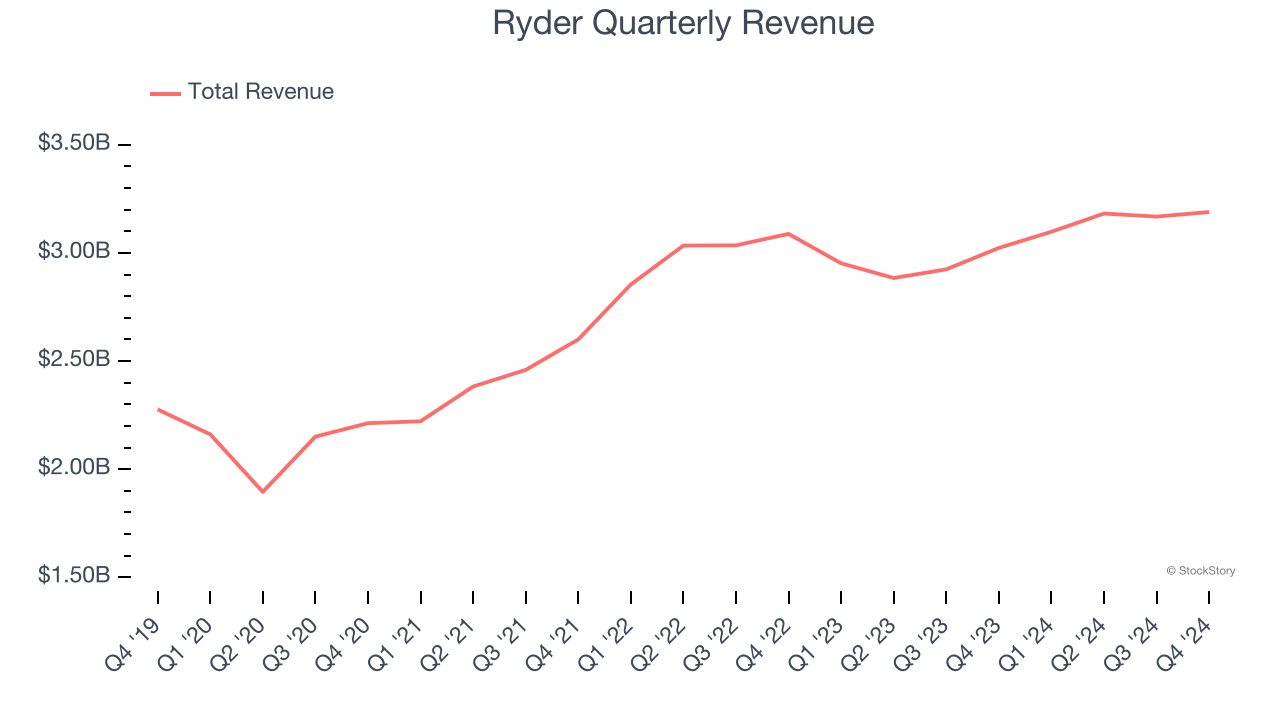
Long-term growth is the most important, but within industrials, a half-decade historical view may miss new industry trends or demand cycles. Ryder’s recent history shows its demand slowed as its annualized revenue growth of 2.6% over the last two years is below its five-year trend. We also note many other Ground Transportation businesses have faced declining sales because of cyclical headwinds. While Ryder grew slower than we’d like, it did perform better than its peers. 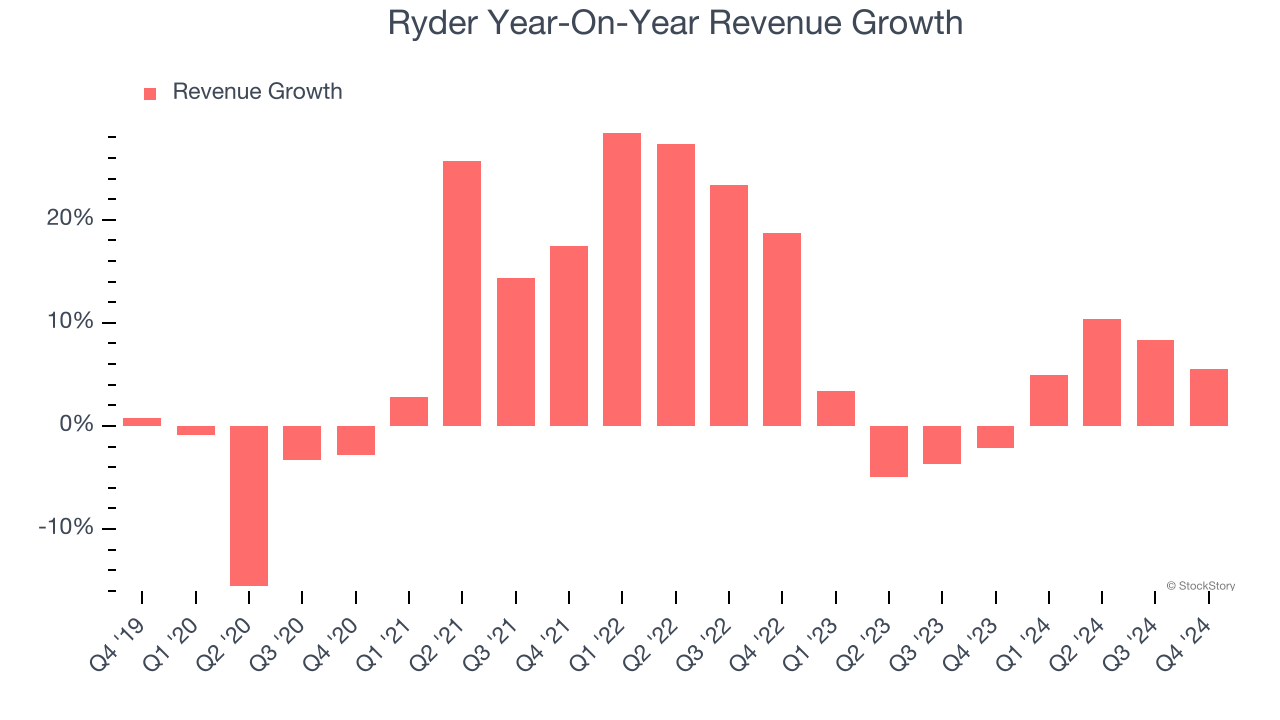
Ryder also breaks out the revenue for its most important segments, Fleet Management Solutions and Supply Chain Solutions, which are 46.6% and 42% of revenue. Over the last two years, Ryder’s Fleet Management Solutions revenue (leasing and rental) averaged 3.5% year-on-year declines. On the other hand, its Supply Chain Solutions revenue ( designing and managing customers' distribution) averaged 6.1% growth.
This quarter, Ryder’s revenue grew by 5.5% year on year to $3.19 billion, missing Wall Street’s estimates.
Looking ahead, sell-side analysts expect revenue to grow 6.3% over the next 12 months. While this projection indicates its newer products and services will spur better top-line performance, it is still below average for the sector.
Here at StockStory, we certainly understand the potential of thematic investing. Diverse winners from Microsoft (MSFT) to Alphabet (GOOG), Coca-Cola (KO) to Monster Beverage (MNST) could all have been identified as promising growth stories with a megatrend driving the growth. So, in that spirit, we’ve identified a relatively under-the-radar profitable growth stock benefiting from the rise of AI, available to you FREE via this link.
Operating Margin
Ryder was profitable over the last five years but held back by its large cost base. Its average operating margin of 7.5% was weak for an industrials business. This result isn’t too surprising given its low gross margin as a starting point.
On the plus side, Ryder’s operating margin rose by 3.5 percentage points over the last five years.
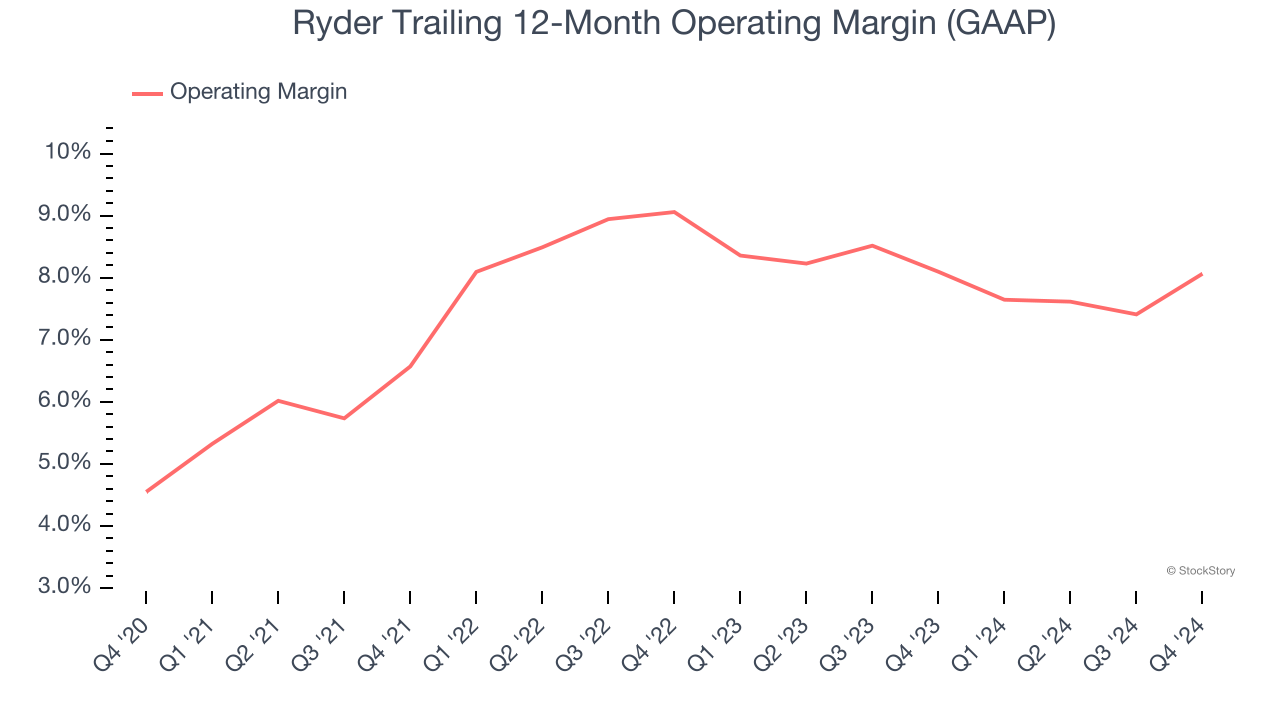
This quarter, Ryder generated an operating profit margin of 8.7%, up 2.7 percentage points year on year. The increase was encouraging, and since its operating margin rose more than its gross margin, we can infer it was recently more efficient with expenses such as marketing, R&D, and administrative overhead.
Earnings Per Share
Revenue trends explain a company’s historical growth, but the long-term change in earnings per share (EPS) points to the profitability of that growth – for example, a company could inflate its sales through excessive spending on advertising and promotions.
Ryder’s EPS grew at an astounding 64.1% compounded annual growth rate over the last five years, higher than its 7.2% annualized revenue growth. This tells us the company became more profitable on a per-share basis as it expanded.
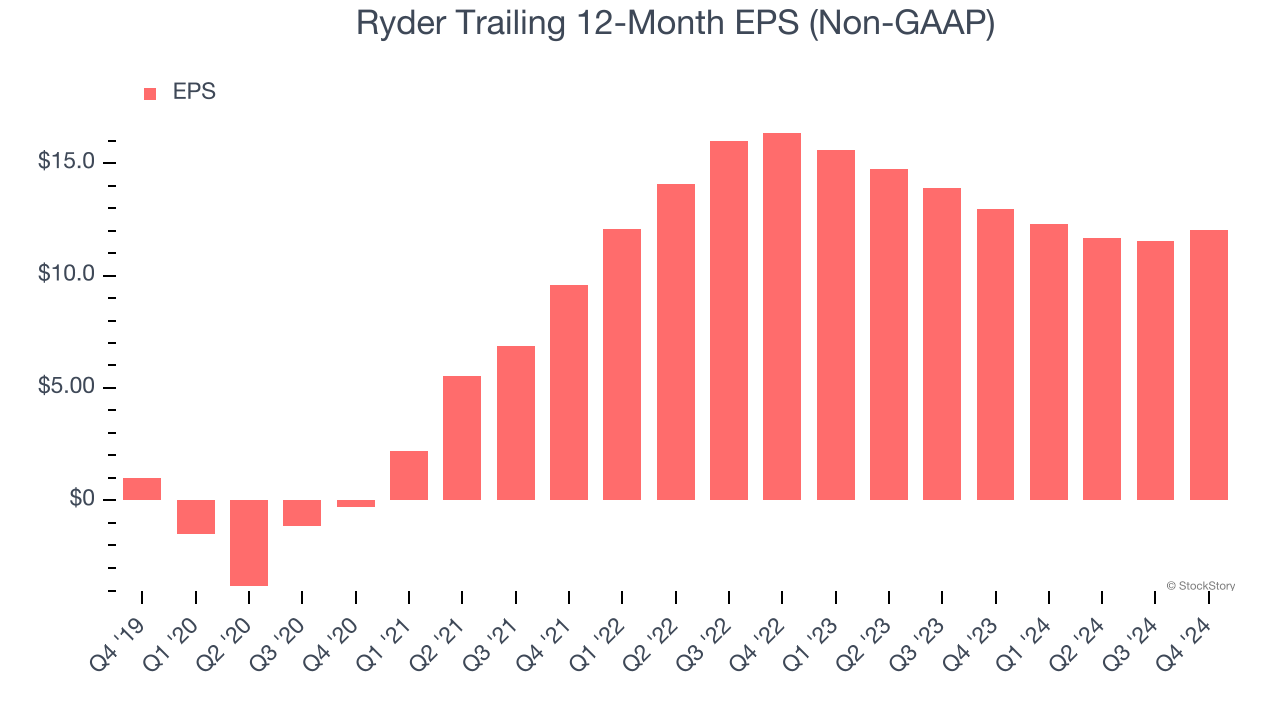
We can take a deeper look into Ryder’s earnings to better understand the drivers of its performance. As we mentioned earlier, Ryder’s operating margin expanded by 3.5 percentage points over the last five years. On top of that, its share count shrank by 17%. These are positive signs for shareholders because improving profitability and share buybacks turbocharge EPS growth relative to revenue growth. 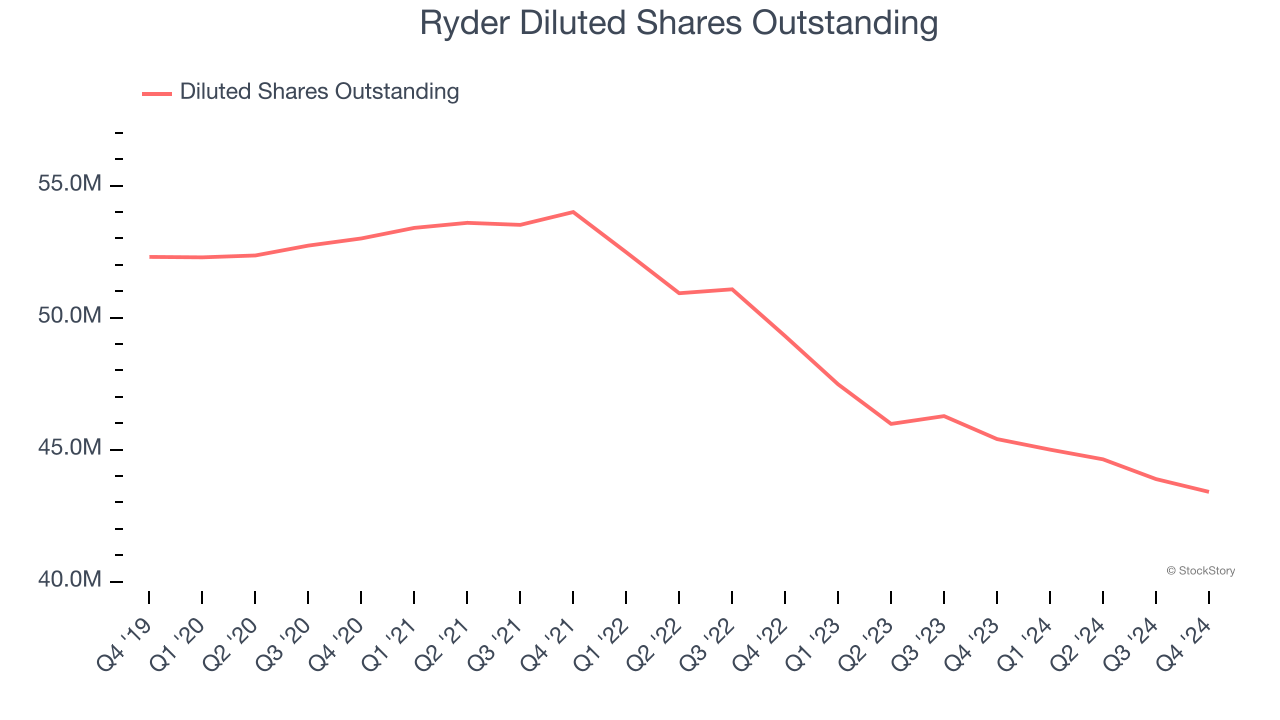
Like with revenue, we analyze EPS over a shorter period to see if we are missing a change in the business.
For Ryder, its two-year annual EPS declines of 14.2% mark a reversal from its (seemingly) healthy five-year trend. We hope Ryder can return to earnings growth in the future.
In Q4, Ryder reported EPS at $3.45, up from $2.95 in the same quarter last year. This print beat analysts’ estimates by 2.3%. Over the next 12 months, Wall Street expects Ryder’s full-year EPS of $12.03 to grow 12.7%.
Key Takeaways from Ryder’s Q4 Results
It was comforting to see Ryder provide full-year EPS guidance that met analysts’ expectations. On the other hand, its revenue missed and its EPS guidance for next quarter fell short of Wall Street’s estimates. Overall, this quarter could have been better. The stock remained flat at $159 immediately following the results.
Big picture, is Ryder a buy here and now? When making that decision, it’s important to consider its valuation, business qualities, as well as what has happened in the latest quarter. We cover that in our actionable full research report which you can read here, it’s free.
